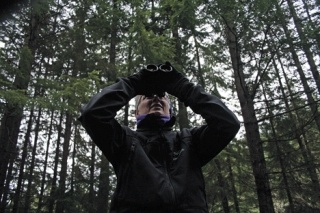Along with the carols, cookies and Christmas revelry, the holiday season was also a time for counting the birds. For the past 109 years, wild birds have been tallied by citizen birders across the U.S. and other parts of the world to help scientists study changes in bird populations.
The Whidbey Island Christmas Bird Count was advertised “in rain or shine,” but an unexpected 17 inches of snow postponed the count for the first time.
“It was a beautiful day, but the snow made it hard to pull off to the side of the road,” Janet Hall of the Whidbey Audubon Society said.
The date was moved to Jan. 3, just within the window for counting. The National Audubon Society accepts numbers from Dec. 13 to Jan. 5.
From dawn-to-dusk, 14 Whidbey birding teams canvassed 15-mile radiuses armed with binoculars, checklists and bird guides. In the back seat of her car, Hall carried a copy of “Sibley’s Guide to Birds” by David Sibley and a number of National Geographic magazines.
The counting tradition began in the 19th century when it was common for hunters to bag a bird for Christmas dinner, and to also hunt them for sport. In 1900, an ornithologist suggested a count instead of a kill at Christmas time. Today, the counts are considered a “citizen science.”
“This was a way to continue the tradition, without killing,” Hall said.
Strategy is important in a successful Christmas bird count, particularly knowing when to hit the good areas. It’s also about knowing which areas to avoid, such as frozen ponds which contain fewer birds, and how long to spend in each place. Hall had spent the previous day scouting the area to create a tentative plan.
She said much of the hunt involves driving, which saves birders precious counting time, but a promising hollow, brush or unfrozen pond is worth a walk. Ken Green’s property, near Taylor Road and Fakemma, contained a bird feeder and a swath of nearby woods-— a good first stop.
Hall marked off a few finches in the thicketed areas, then heard something that caught her interest.
“That was a raven,” she said finally. “You can tell because they have more a throaty call and less of a caw sound.”
Experienced birders can confirm a count with sound alone, and the die-hard birders can even approximate the amount of birds. In the wintertime, this knowledge is useful because birds will often hunker down on windy days, Hall said.
On the outskirts of Deception Pass State Park, following a wide trail, Hall had a difficult time making a visual. There was no one around, but a lot of bird noise. She pointed her binoculars in the direction of the calls and found a healthy number of winter wrens, juncos, along with a scad of other common species. Hall also caught a flash of a brown creeper, a challenging bird to spot because of its well-camouflaged feathers. It creeps along tree trunks, spiraling up the bark.
Several walkable stops were made at local fire stations. Hall said some enthusastic birders will trek into private properties for their counts, but she prefers staying in public areas. At one station, she thought she spotted a great-horned owl but due to the time limitations, she was forced to move on.
“The frustrating part about this type of count is that you can’t sit and watch them. When you go on a species count, you can take your time,” she said.
After lunch, Hall decided to hit the lowlands near the little boating community of Mariner’s Cove. A half-frozen pond was good for the first major mallard flock of the day and the rest of the area was teeming with water fowl, such as goldeneyes and cormorants. A great blue heron croaked its way toward a small bluff filled with gull species.
Just as the sky was growing dark, Hall drove back to Au Sable Institute to rendezvous with the rest of the teams. Birders Sarah Schmidt and Mary Hollen had just finished studying a pine gross beak, a rare bird that wasn’t on the checklist. They took half an hour to confirm it.
“That was my life bird!” Hollen exclaimed.
Hall said the bird might have migrated to lower lands because of the snow in the mountains. Another group had spotted a rare brown pelican, which was on the Endangered Species list in the 1970s.
As with most counts, the group ended with the compilation of data. Hall found she had counted a total of 569 birds. The group’s grand total was 17,968 birds, which was about 2,000 birds less than last year.
The totals will be sent to the National Audubon Society, which create invaluable data for researchers. While birds seldom disappear overnight, populations often increase or decrease over time. In Washington State, there was a major decline in scoters, a type of water fowl. By turning the data into statistics, the Department of Fish and Wildlife can focus their conservation efforts where it is needed most.



